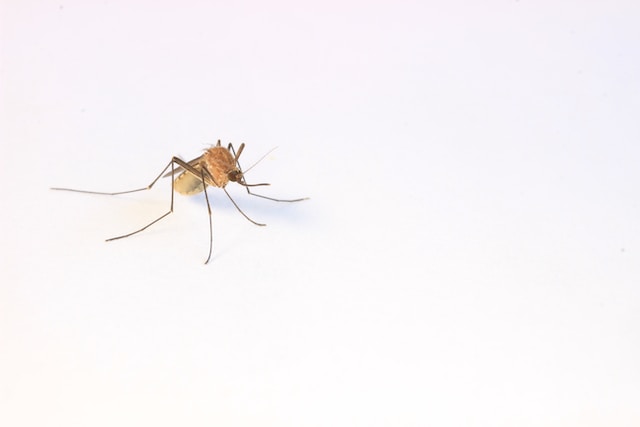As summer bids adieu and temperatures drop, many might assume that pesky mosquitoes will finally retreat. However, in regions like New York’s Orange and Rockland counties, the arrival of fall doesn’t necessarily signal the disappearance of these buzzing insects. While their numbers may dwindle, certain species of mosquitoes remain active well into the autumn months, posing potential concerns for residents.
Keep reading to understand why you may see mosquitoes in the fall and what we can do to keep you pest-free, no matter the season.
Understanding the Life Cycle of Mosquitoes
Like the life stages of a cockroach, a mosquito undergoes a complex life cycle. It consists of four distinct stages: egg, larva, pupa, and adult. The mosquito life cycle is closely tied to water, requiring stagnant water sources for breeding.
In the egg stage, female mosquitoes lay eggs on the surface of standing water or in areas that flood regularly. These eggs hatch into larvae, commonly known as wrigglers, which live in water and feed on organic matter.
Following this, the larvae transform into pupae. This stage is a transitional phase where mosquitoes do not feed but instead undergo metamorphosis. Finally, the adult mosquito emerges from the pupal case and takes flight, beginning the cycle anew.
Fall Mosquito Activity
As the seasons transition to fall in Orange and Rockland counties, certain mosquito species remain active, albeit in reduced numbers. Aedes and Culex mosquitoes are among those species that continue to pose concerns.
Aedes mosquitoes, known for their aggressive biting behavior, are responsible for transmitting diseases like Zika, dengue, and chikungunya. Culex mosquitoes, on the other hand, are potential carriers of West Nile virus.
In fall, cooler temperatures slow down mosquito activity but don’t halt it entirely. Mosquitoes can thrive if temperatures remain above freezing and suitable breeding sites persist. Some species may even seek refuge indoors.
Various factors contribute to mosquitoes thriving in the fall. Extended warm weather, often a result of climate changes, prolongs their activity. Stagnant water sources, like clogged gutters or rain-filled containers, become breeding grounds and support mosquito life cycles.
Fallen leaves and debris trap moisture, offering more habitats for mosquito larvae. With abundant hiding spots and resources, mosquitoes can persist well into the fall season, leaving you with pest issues well beyond the summer months.
Handling Mosquitoes in The Fall
Mosquitoes in the fall can significantly affect outdoor activities and health. Despite a decrease in the overall population, the threat of mosquito-borne diseases persists. Whether engaging in hiking, camping, or merely relaxing outdoors, residents are likely to encounter these pests.
Particularly aggressive species like Aedes mosquitoes can relentlessly cause discomfort through their bites. Furthermore, the looming health risks linked to mosquito-borne diseases demand ongoing vigilance and precautionary measures from residents.
Adopting preventive measures becomes imperative to address the concerns posed by fall mosquitoes in Orange and Rockland counties. Here are some effective strategies to mitigate mosquito-related issues:
- Eliminate Standing Water: Regularly inspect and eliminate stagnant water sources around your property, such as flowerpots, birdbaths, and gutters, to prevent mosquito breeding.
- Use Mosquito Repellents: When spending time outdoors, especially during dusk and dawn when mosquitoes are most active, apply EPA-approved insect repellents to exposed skin and clothing.
- Wear Protective Clothing: Dress in long sleeves, pants, and light-colored clothing to reduce exposure to mosquito bites.
- Screening and Sealing: Ensure windows and doors are equipped with screens to prevent mosquitoes from entering your home. Seal any gaps or cracks that might serve as entry points.
- Professional Pest Control: Consider seeking professional pest control services to assess your property, identify breeding sites, and implement targeted treatments to minimize mosquito populations.
Community engagement also plays a vital role in combating mosquito-related issues. Local authorities, health departments, and residents can collaborate to raise awareness about mosquito-borne diseases and preventive measures. Community clean-up initiatives targeting potential breeding grounds can significantly reduce mosquito populations.
United States Pest Services Mosquito Control in Middletown
While the arrival of fall in New York’s Orange and Rockland counties brings cooler temperatures and the beauty of changing foliage, it doesn’t entirely signal the departure of mosquitoes. Understanding the life stages of a mosquito and the factors influencing its activity in the fall is crucial for residents to remain vigilant.
Residents can minimize the impact of fall mosquitoes by employing preventive measures, fostering community involvement, and staying informed about mosquito habits and potential health risks.
For lasting protection, rely on the experts here at United States Pest Services! We’re here to lend a helping hand against any pest issues you may encounter. Contact us today!

